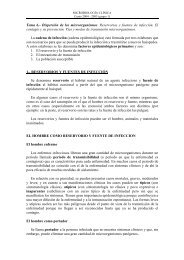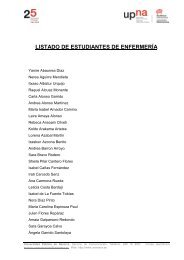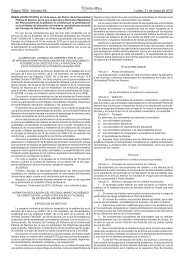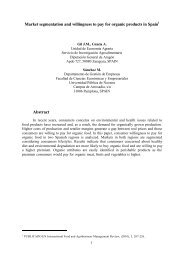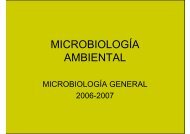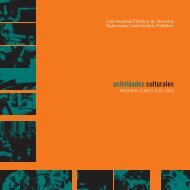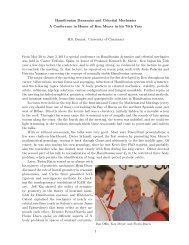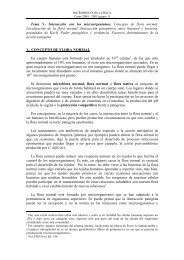Identification of Prosopis juliflora and Prosopis - Universidad Pública ...
Identification of Prosopis juliflora and Prosopis - Universidad Pública ...
Identification of Prosopis juliflora and Prosopis - Universidad Pública ...
You also want an ePaper? Increase the reach of your titles
YUMPU automatically turns print PDFs into web optimized ePapers that Google loves.
Pasiecznik et al. (2001) noted similarities between P. <strong>juliflora</strong> <strong>and</strong> P. pallidasufficient to lead them to treat the two species together as the P. <strong>juliflora</strong>–pallida complex, based on their overlapping geographic range, being the onlytruly tropical American <strong>Prosopis</strong> species, <strong>and</strong> having similar morphology <strong>and</strong>resource characters. The marker L01 (520) was found in both P. <strong>juliflora</strong> <strong>and</strong>P. pallida but not in the other species tested, <strong>and</strong> along with the high similarityindex (0.73), this supports the hypothesis <strong>of</strong> Pasiecznik et al. (2001). However,recent work has suggested a clear division <strong>of</strong> these species using ploidy (Harriset al. 2003), although further detailed studies are still required in areas <strong>of</strong> thenative range where both species have been identified in sympatry to fullyconfirm this.Although this paper did not aim to look for molecular markers specific toNorth American species, the data obtained could differentiate them but alsoclearly show a equivalently high similarity value at 0.70 among P. gl<strong>and</strong>ulosa,P. laevigata <strong>and</strong> P. velutina. Jua´rez-Mun˜ oz et al. (2002) used RAPDs to studythe inter- <strong>and</strong> intra-genetic variation between four wild Mexican populations <strong>of</strong>P. gl<strong>and</strong>ulosa, P. laevigata <strong>and</strong> P. <strong>juliflora</strong> <strong>and</strong> found a genetic variation <strong>of</strong>72.48% between them <strong>and</strong> 27.52% within them, <strong>and</strong> postulated that P. <strong>juliflora</strong>gave rise to the other two species. It may be postulated that these NorthAmerican species could be grouped together into a species complex as has beensuggested by Pasiecznik et al. (2001), <strong>and</strong> South American species <strong>of</strong> sectionAlgarobia also show patterns <strong>of</strong> clustering (Ramírez et al. 1999).Several authors have observed that sympatric <strong>Prosopis</strong> species, where noreproductive isolation exists, are able to form stable fertile hybrids (Hunzikeret al. 1975; Simpson 1977a). Hybrids have been identified in North AmericaJohnston 1962; Solbrig et al. 1977) <strong>and</strong> South America (Hunziker et al. 1975,1986; Burkart 1976; Saidman 1985, 1990). Tentative evidence for a P. pallida· P. chilensis hybrid was provided by this study. Burkart (1976) described aputative hybrid between P. <strong>juliflora</strong> <strong>and</strong> P. pallida in northern Ecuador butnoted that it could be a form <strong>of</strong> P. <strong>juliflora</strong> var. horrida (Kunth) Burkart.Johnston (1962) noted that P. inermis H.B.K. (syn. P. <strong>juliflora</strong> var. inermis(H.B.K.) Burkart) may be a synonym <strong>of</strong> P. pallida. Harris et al. (2003) haveidentified a putative hybrid <strong>of</strong> P. <strong>juliflora</strong> <strong>and</strong> P. pallida in Cape Verde based onploidy, but suggest that while hybrids may form they could be sterile.Pasiecznik et al. (2001) also divided the P. <strong>juliflora</strong>–pallida complex intothree geographically distinct groups; (1) Peru <strong>and</strong> Ecuador, (2) Colombia,Venezuela <strong>and</strong> the Caribbean isl<strong>and</strong>s, <strong>and</strong> (3) Pacific coastal Central American.Accessions from groups 1 <strong>and</strong> 3 were analysed in this study <strong>and</strong> found to begenetically distinct. Range-wide analysis is, however, required in order t<strong>of</strong>urther elucidate the genetic relationships within the P. <strong>juliflora</strong>–pallida complex.Burkart (1976) divided section Algarobia into six series. According toBurkart (1976), P. chilensis, P. <strong>juliflora</strong>, P. gl<strong>and</strong>ulosa, P. laevigata <strong>and</strong>P. velutina are all <strong>of</strong> series Chilenses, while P. pallida is in series Pallidae. Thisstudy clearly differentiated P. pallida <strong>and</strong> P. <strong>juliflora</strong> from each other <strong>and</strong> from13






